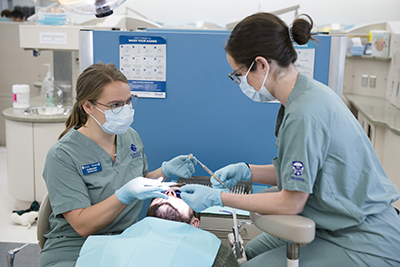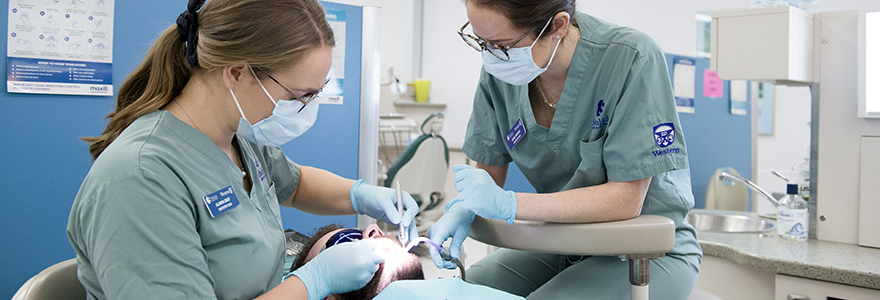Four-handed dentistry
By Crystal Mackay, MA ‘05
You’ve practised dozens of times on a model. You’ve shadowed other students in clinic. You’ve seen this procedure online and in lecture, but you can’t help feeling intimidated walking into the clinic to treat patients for the first time.
When third-year dental students meet their first patient in the School’s dental clinic, it can be an overwhelming experience. But now, thanks to a new clinic model at Schulich Dentistry, they don’t have to go at it alone.
The new model, which began in spring of 2019, pairs third- and fourth-year students together for their operative clinical cases. One student acts as the lead, and the second as a dental assistant. They switch these roles throughout the semester so each has a chance to act as the lead and the assistant on any given day.
Third-year Dentistry student Wayne Cutinha says having his fourth-year partner working alongside him on the first day was a game changer for him. “As a third year, the idea of working in the clinic for the first time can be a very overwhelming experience. However, the implementation of the new clinic model created a very streamlined entry, as I was going in with the confidence knowing I had a good mentor by my side who I could work with and learn from.” The model more closely mimics community dental practice, where dentists perform what’s known as ‘four-handed dentistry’ with a second set of hands to perform suction, prepare equipment and help install rubber dams.
The model more closely mimics community dental practice, where dentists perform what’s known as ‘four-handed dentistry’ with a second set of hands to perform suction, prepare equipment and help install rubber dams.
“The paradigm in dentistry is to work with an assistant, which allows for safer, better quality, more efficient treatment,” said Dr. Rae Dorion, Assistant Professor and the new Clinic Director at Schulich Dentistry. “Because we expect our students to perform at the level of a competent dental practitioner, if they have to work alone to do all their procedures, it's like they have two hands tied behind their back.”
Dr. Dorion says pairing the students allows the fourth years to provide mentorship and coaching to their junior colleagues, but also to complete their treatment faster so there are fewer sessions, and it allows them to have someone to call on an instructor or go to the dispensary while the other stays with the patient.
“This model gives us better patient-centred care,” said fourth-year student Alanna Skot. “It allows the appointment to run more smoothly, and leads to better continuation of care. It’s a better experience for both our patients and for us as students.”
Jamie Barron, who is paired up with Skot, says her fourth-year partner has been extremely advantageous to her training. “To have a second opinion and a second set of eyes has been really helpful and comforting. Alanna has been instrumental in my learning.”
Cutinha agrees. “After every appointment, I ask my partner for his feedback on where I can improve. That’s a huge advantage to this system,” he said. “We learn from each other and push each other to become better clinicians.”
This model was pioneered at Boston University and the University of the Pacific. The advantage is that students are exposed to the entire spectrum of diagnosis and treatment planning.
“It allows students to see the forest and not just the trees when it comes to treatment,” Dr. Dorion said. “For each individual patient you have to take into account their socioeconomic background, the patient’s value system and underlying medical conditions. This is a much more holistic approach to dentistry rather than just putting a filling in a tooth.”









